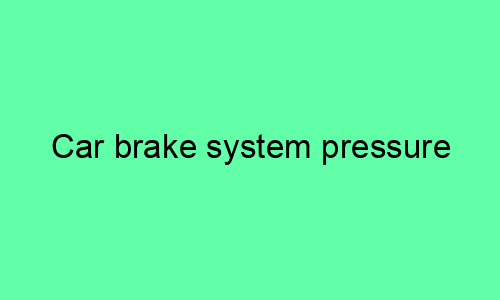Car Brake System Pressure
Introduction
The brake system is one of the most important safety features on a car. It allows the driver to slow down or stop the vehicle quickly and safely. The brake system uses hydraulic pressure to apply force to the brake pads, which in turn apply friction to the brake rotors to slow down the wheels.
The hydraulic pressure in the brake system is generated by the master cylinder. The master cylinder is a piston that is connected to the brake pedal. When the driver presses the brake pedal, the piston moves down and forces brake fluid into the brake lines. The brake lines carry the brake fluid to the calipers, which are located at each wheel.
The calipers contain pistons that are connected to the brake pads. When the brake fluid enters the calipers, it forces the pistons to move outward and apply pressure to the brake pads. The brake pads then apply friction to the brake rotors, which slows down the wheels.
The pressure in the brake system is very high, typically around 1,000 psi. This high pressure is necessary to generate enough friction to slow down or stop the vehicle.
Brake System Components
The brake system consists of the following components:
* Master cylinder
* Brake lines
* Calipers
* Brake pads
* Brake rotors
Master Cylinder
The master cylinder is a piston that is connected to the brake pedal. When the driver presses the brake pedal, the piston moves down and forces brake fluid into the brake lines. The master cylinder is typically located under the hood of the car.
Brake Lines
The brake lines are tubes that carry brake fluid from the master cylinder to the calipers. The brake lines are typically made of steel or rubber.
Calipers
The calipers are located at each wheel. They contain pistons that are connected to the brake pads. When the brake fluid enters the calipers, it forces the pistons to move outward and apply pressure to the brake pads.
Brake Pads
The brake pads are made of a friction material that is applied to the brake rotors. When the brake pads are pressed against the brake rotors, they create friction that slows down the wheels.
Brake Rotors
The brake rotors are discs that are attached to the wheels. The brake pads apply pressure to the brake rotors to slow down the wheels.
How the Brake System Works
When the driver presses the brake pedal, the master cylinder forces brake fluid into the brake lines. The brake fluid travels through the brake lines to the calipers. The calipers then force the brake pads against the brake rotors. The friction between the brake pads and the brake rotors slows down the wheels.
The amount of pressure in the brake system determines how quickly the vehicle will slow down or stop. The harder the driver presses the brake pedal, the more pressure will be applied to the brake system and the more quickly the vehicle will slow down or stop.
Brake System Maintenance
The brake system is a critical safety feature on a car. It is important to keep the brake system in good working condition by performing regular maintenance. Brake system maintenance includes:
* Checking the brake fluid level
* Inspecting the brake pads
* Inspecting the brake rotors
* Flushing the brake fluid
* Replacing the brake pads and rotors as needed
By following these maintenance tips, you can help to keep your brake system in good working condition and ensure that your vehicle is safe to drive.
Conclusion
The brake system is one of the most important safety features on a car. It allows the driver to slow down or stop the vehicle quickly and safely. Understanding how the brake system works and how to maintain it will help you to keep your vehicle safe to drive.






